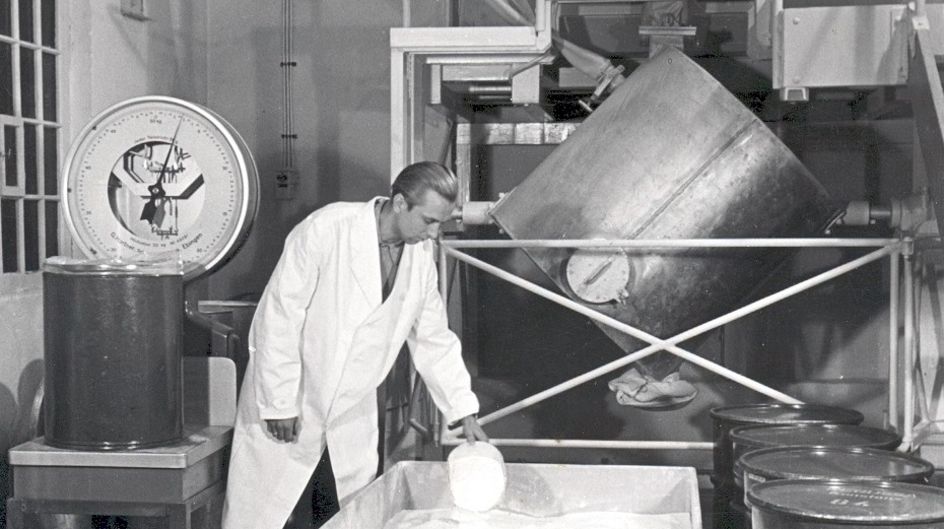Evonik and livestock
Methionine - a success story

Methionine is a sulfur-containing amino acid whose production is based on the starting products acrolein, methyl mercaptan and hydrogen cyanide. Amino acids are the building blocks of every protein and thus vital nutrients for humans and animals. Some of them, including methionine, cannot be produced by the body itself and must therefore be supplied with food. Poultry need a particularly large amount of methionine in their feed. As a rule, the methionine naturally occurring in feed raw materials (e.g. grain, soybean meal) is not sufficient to meet the animals' needs. Industrially produced DL-methionine closes this supply gap.
The history of methionine begins in the early twenties of the last century. J. H. Mueller, a researcher at Columbia University, New York, isolated a "sulfur-containing amino acid" in 1922, but gave an incorrect molecular formula. Three years later, his colleague Odake in Japan corrected this formula and gave the amino acid the name "methionine". Six years later, G. Barger and F. P. Coyne determined the structure of this amino acid.
In the post-war period, researchers at the Deutsche Gold- und Silber-Scheideanstalt (from 1980: Degussa AG) built on these findings. The synthetic amino acid methionine was used to counteract hunger oedema, which is widespread in Germany, especially among war returnees, and which occurs as a result of a chronic protein deficiency. The first technically feasible synthesis of DL-methionine at Degussa was achieved in 1946/47 by Werner Schwarze, Hans Wagner and Hermann Schulz.
Since the most important precursors for methionine - acrolein and hydrogen cyanide - could be produced at Degussa (in 1936 Wagner and Schulz carried out the synthesis of acrolein from acetaldehyde and formaldehyde), the research laboratories outsourced to Konstanz began work in 1946. As early as June 1948, Werner Schwarze was able to present the first 1 kg sample to the scientific director of Chemiewerk Homburg AG, a pharmaceutical subsidiary of the then Degussa. Production of DL-methionine began at the Konstanz plant.
The development from the pilot plant with a capacity of 300 kg per month to production with a capacity of 30 tons per month took only one year. The Konstanz methionine was of pharmaceutical quality and shortly afterwards Chemiewerk Homburg AG launched the first drug with DL-methionine content (0.5 g per tablet) on the market under the name "Thiomedone".
Another possible application for methionine arose a few years later, when methionine was shown to improve laying performance in a feeding trial with laying hens. Initially, however, Degussa did not have its own know-how in animal nutrition. It was not until 1953, after initial feeding trials, that the working group "Introduction and Promotion of DL-Methionine and Similar Products" was launched. In the same year, methionine was approved by the Ministry of Agriculture in Bonn for use in animal feed. An amino acid laboratory for the quantitative and qualitative determination of amino acids in feed, compound feeds and premixtures was established in 1960. With increasing success, the areas of application were expanded and new amino acids were developed.
In 1967, methionine production started at the Wesseling plant in Germany, and seven years later the first methionine plant was commissioned at the Antwerp site in Belgium. Production began in 1977 at the Mobile plant in Alabama, USA. In the years that followed, the production capacity in the existing plants was continuously expanded to 230,000 metric tons per year.
In order to meet the increasing global demand for DL-methionine in animal feed, further large-scale plants were commissioned in 2006, 2014 and 2019: one plant with a production capacity of 120,000 tonnes in Antwerp and two with a capacity of 150,000 tonnes each in Singapore. The smallest of Evonik's methionine plants – the one in Wesseling – was shut down in 2021.
With three methionine hubs on three continents – Antwerp, Belgium; Mobile, Alabama, USA; and Singapore – and a total capacity of more than 700,000 metric tons of DL-methionine, Evonik now supplies the global growth markets. Evonik's current focus is on measures to reduce the CO2 footprint of the manufacturing process and to strengthen global supply security.
Today, Evonik Industries offers a wide range of amino acids for animal nutrition, food, and pharmaceuticals. DL-methionine (MetAMINO®) is primarily used in animal nutrition. The amino acid contributes to the healthy, efficient and sustainable nutrition of farm animals.
